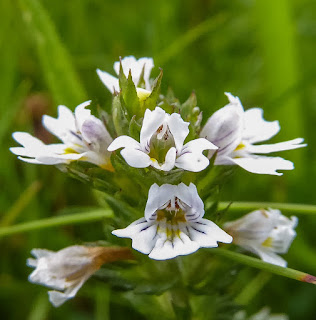My personal diary of walking in The Lake District, travels in France and Switzerland. Much of the walking is on the fells and mountains around Coniston, Langdale and Keswick areas. I am a keen photographer of Landscapes and nature, which includes wild flowers, butterflies and other animals that I spot on our walks. I am a member of The National Trust, Cumbria Wildlife Trust and the RSPB.
Tuesday, 9 August 2016
Summer wild flowers on Cunswick Scar.
Where to explore next? Well after a brief discussion on the subject, Mrs Cooper fancied some different terrain, some limestone underfoot and I agreed that it would make a pleasant change and maybe a variation in the wildlife. So we set off to walk Cunswick Scar near Kendal. We parked at the bottom of the tramway on Queens Road in Kendal, the tramway had been an old link of about quarter a mile, to a limestone quarry on the fell just above the town. Nowadays the tramway is a paved lane that leads to footpaths across Kendal golf course. This had been a very regular route for us when we lived in Kendal. At one time we lived on Serpentine rd and did the walk most nights after work. So it was interesting to see some different terrain, whilst at the same time, visiting an old familiar route. Familiar that is until we got onto the golf course, where a wall that the path used to follow had gone and the route not as clear as we remembered it. The path from the end of the tramway up to the fairways was covered in all kinds of wild flowers, the dominant species must have been the scabious, looking beautiful in their full, summer bloom.
Scabious covering the grassy hillsides around Kendal golf course.
The bees were making the most of the summer.
Kidney Vetch, another summer flower that prefers limestone meadows and heaths.
Agrimony, adding to the patchwork of colour along the footpath.
Bettony, seems to occur in a variety of locations. It appears to be as happy here on well drained limestone as it is in the damp areas around the lakes.
Potentilla, a small geum that gaws all over the limestone heaths.
So taking our chances, we crossed the golf course without incident, looking for the stile in the wall on the other side of the fairway. Things didn't quite look the same, but then we spotted a gate in a corner where two walls met. furthe on again, another gate, all of the stiles appear to have been replaced by gates. Easier access I gueass, but a slight change in the character of the walk. I'm happy with gates if it means the walk is accessible to more people. Across another field and the path crosses the A591 via a specially constructed bridge.I'm very glad they put the bridge there when they built the Kendal by-pass, I wouldn't fancy trying to cross the main road into the lakes from the south! Across another field and out onto the open scar, with a cairn at it's highest point. The 360 degree views were a bit hazy today with the appearance of showers in the distance. But we could see the fells of Coniston, Langdale, Ambleside, Kentmere and out to Long Sleddale. We could see the Howgills, Benson Knott and down the lower Kent Valley.
Looking south from Cunswick Scar, back across the golf course.
Always good to see a variety of butterflies. This one is a Painted Lady.
Small Copper
I'm not totally sure about this one, maybe a very faded Meadow Brown?
Eyebright, a tiny little flower which is actually a prasitic plant, growing everywhere up on the scar.
Hare Bell, another prolific flower at the moment that seems to thrive in a variety of conditions.
Scattered across the scar is the eye catching yellow of the Hawkbit, seen here growing against a limestone wall.
The path follows the line of the escarpment almost to the point where it meets Scout Scar, where there is a cross roads in the footpaths and we took the one down towards Bradley Field. The path heads down through thick gorse bushes where we remembered seeing lots of rabbits bouncing around infront of us, usually around thirty every evening. Today the path was quiet, no sogn of the burrow at all. Rabbits appear to be in decline yet again, but with their capacity to make a come back I'm sure it won't be long before they are a common sight again. At Bradley Field the path joins the Underbarrow road which took us back into Kendal, but still plenty to see here. The roadsides had yet more wild flowers to show, with field geraniums, teasels and giant bellflowers to name the most noteable ones.
Field Geranium
Teasel
The Giant Bellflower which can grow to a height of five feet. Definitely a plant that loves limestone.
And as we approached the outskirts of the town, we stopped to have a look at the old, restored lime kilns. Here we photographed Indian Balsam. As the name suggests, it was imported from the Indian sub continent into parks and gardens. In recent years it has become something of a problem in the wild as it colonises and dominates where native plants once grew and in some areas steps are taken to control it. All the same, it is a beautiful flower. A very enjoyable hour and a half, walking the limestone escarpment to the north west of Kendal, photographing some of it's many wild flowers and butterflies.
Subscribe to:
Post Comments (Atom)



















No comments:
Post a Comment